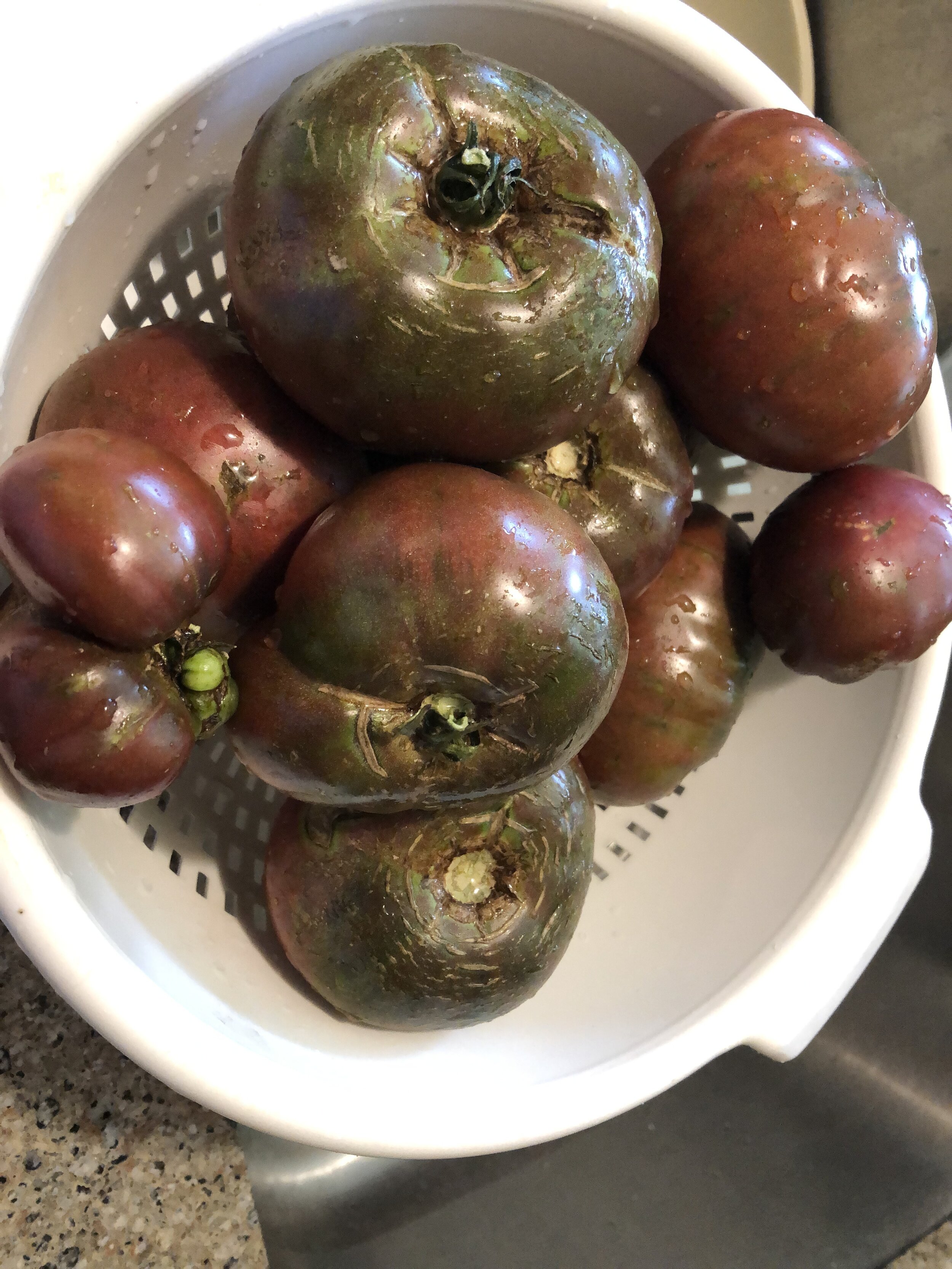Heirloom Tomatoes: History, Recipes, Flavor
Tomato season means the peak of flavor.
Caprese salad made with just-picked basil, buffalo mozzarella, and most importantly, heirloom tomatoes picked earlier in the day—food for the gods.
If you don’t grow basil, and you have no buffalo mozzarella, make do with basil from the produce department and another good quality mozzarella. But if you don’t grow your own tomatoes, you must go to a local farmer’s market or chat up a friendly, tomato-growing neighbor.
There’s no substitute for the perfect heirloom tomato—at least not, in my opinion. If you need a Caprese salad recipe, check out this one.
What is an heirloom tomato?
‘Heirloom’ has come to mean tomatoes that are not the insipid tomato lookalikes commonly sold as the real thing. Instead, the seeds were carefully collected, replanted, and passed down to new gardeners.
The names commonly reflect their origin and a little bit of history.
For instance, one of my favorites, Black Krim, is thought to have originated with soldiers returning home from the Crimean War. The autonomous republic of Crimea is also known as Krim. The seeds were saved and eventually spread to other parts of the world.
Black Krim tomatoes are dusky purple or nearly black, rich, with a slightly salty flavor making them exceptional for fresh eating or use in juices and cocktail drinks. To me, they are every bit as good as San Marzanos, for sauces, too.
Another favorite tomato story is that of the Mortgage Lifter tomato.
This popular variety was developed by Marshall Cletis Byles of Logan, West Virginia.
It was the midst of the Great Depression, and Byles needed a reliable source of income besides his auto mechanic business, where he was known as Radiator Charlie. I’m guessing he must have loved tomatoes, or he knew how much his neighbors did because he decided to breed a tomato that could feed an entire tomato.
He started with four plants: German Johnson, Beefsteak, an unknown Italian variety, and an unknown English variety. Each breed of tomato can cross-pollinate with the others, so Mr. Byles carefully pollinated each plant with pollen from the others. The next year, he planted the seeds from the best tasting and heaviest producing plants.
Byles continued this process for six years until he had seeds that reliably produced the same type of delicious tomato.
The tomato was named after him: Radiator Charlie’s Tomato and was tremendously popular. People drove great distances and paid $1.00 each for his seedlings. Charlie paid off his $6,000 mortgage in 6 years.
Byles’ legacy is now called Radiator Charlie’s Mortgage Lifter Tomato.
In the mid-1980s, Radiator Charlie shared the seeds of the Mortgage lifter Tomato plants with the Southern Exposure Seed Exchange, which has kept the variety alive and in high demand.
Mortgage Lifters are big, an average of two to four pounds. They are meaty with few seeds, hardy, and considered one of the tastiest heirloom tomatoes.
This year in central Texas, cool weather has created a record tomato crop.
Or at least for us. My son has just two four-foot by eight-foot beds of tomatoes, but he’s picking about 25 hefty Black Krim tomatoes every day. He’s shared with friends and family, and I’ve made plenty of Caprese Salads, and still, the tomatoes ripen. It’s time for the sauce.
He’s a proficient cook but hadn’t made a marinara sauce from fresh tomatoes before, so I broke down the steps.
Nana’s Fresh Tomato Marinara Sauce
about 3 to 5 pounds of great-tasting tomatoes. I suggest heirloom varieties.
fresh garlic cloves, peeled and roughly chopped. The quantity depends on taste. I use about 10 average-sized.
salt to taste
sugar to taste
lemon juice or red wine vinegar to taste
olive oil
Begin by heating two quarts of water to boiling while you carefully wash your tomatoes. You will use this to dip the tomatoes in to loosen their skins.
Prepare a bowl with ice water to cool the tomatoes off after dipping them in the boiling water.
Put a colander in the sink to drain the tomatoes in after dipping in the boiling water.
Carefully lower each tomato into the gently boiling water. Put in three or four at a time and gently move them around for about one minute. Remove with a slotted spoon and put them in the ice water to quickly cool and then into the colander. Repeat with all the tomatoes.
Peel and chop the garlic. In a large pot, gently saute until slightly cooked and aromatic over medium-low heat.
Peel and de-seed the tomatoes. Cut around the stem and gently slide the skin off. Slice each tomato in half along the midline. Hint: picture the equator of the tomato. Gently squeeze the tomato over a bowl and squeeze out most of the seeds. It’s ok if the tomatoes fall apart. Place all your skinned and seeded tomatoes in the pot with the garlic.
Reduce the mixture in half by gently simmering, stirring every 10–15 minutes. An easy way to picture this is by measuring the depth of the original mixture; if you start with six inches deep, simmer until you only have three.
Once your sauce is reduced, taste it. Too bland? Add some acidic vinegar or lemon juice. Too acidic? Balance with a bit of sugar.
And, of course, salt to taste.
You may be surprised to find you end up with only 1 to 1.5 quarts of sauce. Refrigerate for a few days if you don’t use for pasta or pizza sauce right away. You can also freeze the sauce for several months.


